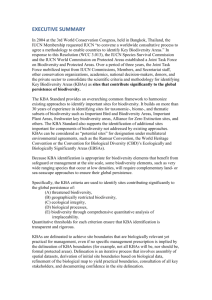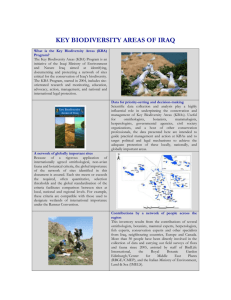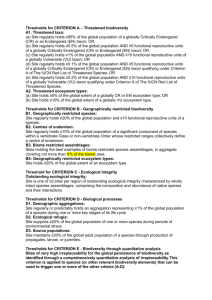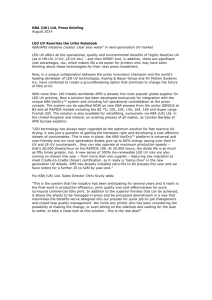2006.05.02 Discussion of agenda for Key Biodiversity
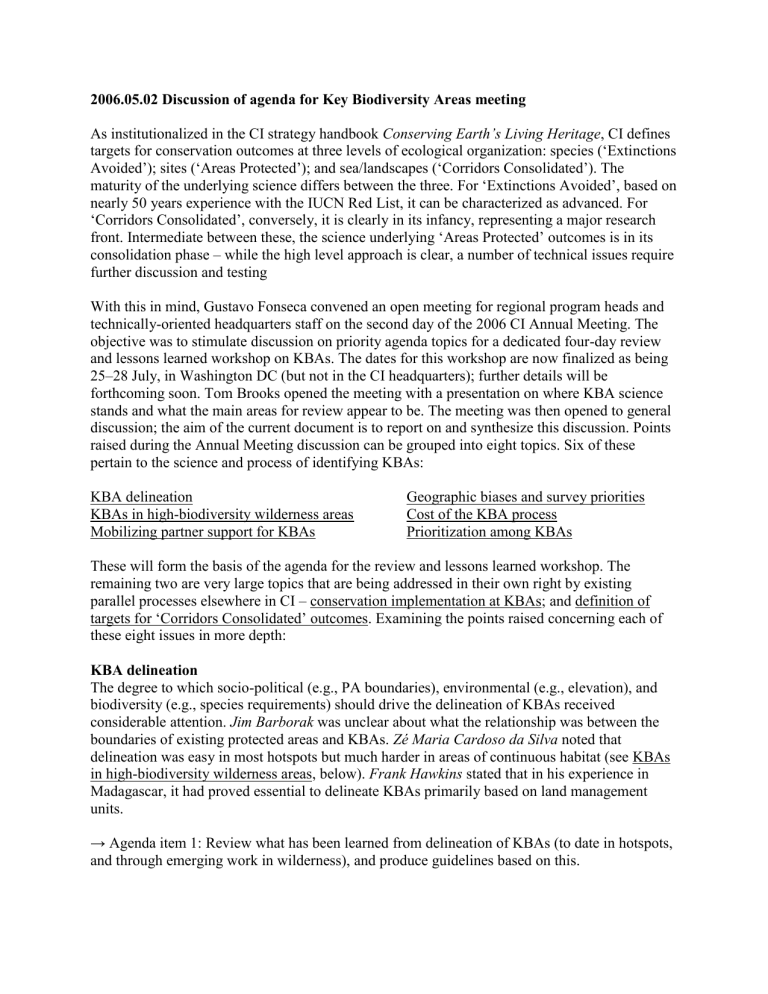
2006.05.02 Discussion of agenda for Key Biodiversity Areas meeting
As institutionalized in the CI strategy handbook Conserving Earth’s Living Heritage , CI defines targets for conservation outcomes at three levels of ecological organization: species (‘Extinctions
Avoided’); sites (‘Areas Protected’); and sea/landscapes (‘Corridors Consolidated’). The maturity of the underlying science differs between the three. For ‘Extinctions Avoided’, based on nearly 50 years experience with the IUCN Red List, it can be characterized as advanced. For
‘Corridors Consolidated’, conversely, it is clearly in its infancy, representing a major research front. Intermediate between these, the science underlying ‘Areas Protected’ outcomes is in its consolidation phase – while the high level approach is clear, a number of technical issues require further discussion and testing
With this in mind, Gustavo Fonseca convened an open meeting for regional program heads and technically-oriented headquarters staff on the second day of the 2006 CI Annual Meeting. The objective was to stimulate discussion on priority agenda topics for a dedicated four-day review and lessons learned workshop on KBAs. The dates for this workshop are now finalized as being
25–28 July, in Washington DC (but not in the CI headquarters); further details will be forthcoming soon. Tom Brooks opened the meeting with a presentation on where KBA science stands and what the main areas for review appear to be. The meeting was then opened to general discussion; the aim of the current document is to report on and synthesize this discussion. Points raised during the Annual Meeting discussion can be grouped into eight topics. Six of these pertain to the science and process of identifying KBAs:
KBAs in high-biodiversity wilderness areas
Geographic biases and survey priorities
Mobilizing partner support for KBAs
These will form the basis of the agenda for the review and lessons learned workshop. The remaining two are very large topics that are being addressed in their own right by existing
these eight issues in more depth:
KBA delineation
The degree to which socio-political (e.g., PA boundaries), environmental (e.g., elevation), and biodiversity (e.g., species requirements) should drive the delineation of KBAs received considerable attention. Jim Barborak was unclear about what the relationship was between the boundaries of existing protected areas and KBAs.
Zé Maria Cardoso da Silva
noted that
Frank Hawkins stated that in his experience in
Madagascar, it had proved essential to delineate KBAs primarily based on land management units.
→ Agenda item 1: Review what has been learned from delineation of KBAs (to date in hotspots, and through emerging work in wilderness), and produce guidelines based on this.
KBAs in high-biodiversity wilderness areas
While the identification and delineation of KBAs is far advanced in hotspots, it has been much slower in high-biodiversity wilderness areas, due to the paucity of primary biodiversity data (see
Geographic biases and survey priorities, below) and to the difficulty of KBA delineation in areas
of continuous habitat (see KBA delineation, above).
Rob Bensted-Smith asked whether the identification KBAs is even necessary in high-biodiversity wilderness areas. Gustavo Fonseca responded by emphazing the importance of proactive conservation in high-biodiversity wilderness areas, applying the irreplaceability criteria for KBAs to identify “latent” KBAs. Zé
Maria Cardoso da Silva noted that clearer guidelines were necessary for identifying KBAs and candidate KBAs in high-biodiversity wilderness areas, especially those like Amazonia where some parts of the region already resemble hotspots. Roger James noted that in New Guinea it is possible to identify KBAs using both the irreplaceability and the vulnerability criteria, using modeling techniques to inform KBA delineation in the absence of clear land tenure. He also suggested exploring the use of the “biome-restricted assemblages” irreplaceability criterion, which Claude Gascon referred to as “intact faunal assemblages”. Lisa Famalore worried that in the southern Guianas, sampling biases would mean that KBAs are identified in accessible areas, not truly important areas; Russ Mittermeier explained that there is no reason not to identify
KBAs even where data are imperfect, and that these can be refined later as data improve (as, indeed, has been done with hotspots and high-biodiversity wilderness areas at the global scale).
→ Agenda item 2: Review methods developed for the identification of KBAs using both the vulnerability and the irreplaceability criteria in the Amazonia and New Guinea high-biodiversity wilderness areas, including use of the “assemblage” irreplaceability criteria, and use of modeling techniques to support delineation, and produce guidelines based on this.
Mobilizing partner support for KBAs
Clearly, CI cannot conserve all biodiversity alone, and so a critical question is how we can mobilize partners to support work towards our targets for conservation outcomes. This is as true at the site scale as it is at the species and corridor scales. Rob Bensted-Smith raised the question of how it is possible to simultaneously have a institutionally standard methodology but at the same time work with partners (especially governments) who may have other priorities. Russ
Mittermeier countered that we must retain our focus on biodiversity, supporting partnerships where they match our priorities. Gustavo Fonseca agreed, giving the example of the CI use of hotspots for prioritization at the global scale – while many partners don’t share this same prioritization technique, CI perseverance with the hotspots agenda has led to the emergence of the only two major conservation funds explicitly focused on global biodiversity conservation priorities (CEPF and GCF).
Zé Maria Cardoso da Silva
related experience from the Cerrado, where CI had been able to ensure the inclusion of KBAs in the results of a planning process in which TNC was using vegetation types and WWF using ecoregions. Romy Trono concurred that selling the KBA concept had not been hard in the Philippines, because CI-Philippines had been careful to build the process from past work, and that there was now wide acceptance, including from the government, that KBAs are the priority sites for biodiversity conservation in the country.
→ Agenda item 3: Review partner uptake and acceptance of KBAs, including in regions where
CI has no CBCs or regional programs, and examine common factors contributing to success.
Geographic biases and survey priorities
Setting priorities for conservation must always be based on known occurrence data (to avoid commission errors, which can allow extinction). As a result, however, the large geographic biases in occurrence data cause omission errors – we may miss important sites. It is therefore very important to prioritize biodiversity surveys (e.g., RAPs), the results of which will reduce these omission errors. Rob Bensted-Smith asked how we can use such complementary methodologies in data poor regions to help address the limitations of KBAs. Tom Lacher noted that a number of tools are available to estimate probabilities of species’ occurrences, which could provide consistent methodologies to identify biodiversity research priorities and identify candidate KBAs.
→ Agenda item 4: Combine CI expertise in RAP techniques and in remote sensing to develop methodologies to prioritize biodiversity surveys and identify candidate KBAs, as pioneered, for example, in Melanesia and China.
Cost of the KBA process
A concern from a number of CI regional programs has been the cost of the KBA identification process, and a perception that it may be hard to raise restricted funds for this work. However,
Zé
Maria Cardoso da Silva argued that KBA identification is actually rather cheap, providing that sufficient biodiversity expertise is available on staff, while delineation is more expensive (see
→ Agenda item 5: Review how KBA processes have been funded through CI to date, approximately how much each component of the process has cost, and, if possible, estimate the potential cost of not identifying KBAs.
Prioritization among KBAs
Once KBAs have been identified, it is clearly essential to prioritize conservation implementation among these. The most obvious system of KBA prioritization developed to date is the identification of the “tip-of-the-iceberg” sites holding the entire populations of one or more
Critically Endangered or Endangered species, by the Alliance for Zero Extinction (AZE).
However, preliminary work in the Philippines, China, and elsewhere suggests that prioritization among KBAs requires other tiers in addition to AZE. Marc Steininger raised the question of prioritization as an important issue, and Russ Mittermeier agreed, noting that the eventual identification of 10–20,000 KBAs worldwide will require prioritization to avoid being overwhelming to donors. Romy Trono added that this was essential for partners too, with, for example, the GEF4 incorporating the highest priority KBAs as targets for investment in the
Philippines. Gustavo Fonseca noted that prioritization was likely a big enough topic to require a workshop in its own right, but that some discussion on the subject could at least identify the major questions.
→ Agenda item 6: Review work in prioritization among KBAs to date, and identify major pending questions and a process to address these.
Conservation implementation at KBAs
Of course, the identification, delineation, and prioritization of site scale targets for conservation is in no way an end in itself, but rather the first steps in a process that must be followed by planning and implementation at the site itself (and subsequently by monitoring, as well). David
Hess asked how CI ensures that identified KBAs are conserved, while Tyler Christie was similarly concerned about linking the science of KBA identification through to implementation.
More specifically, Olivier Langrand queried the degree to which CI should be involved in advocating KBA conservation in hotspots where we have little presence, such as the
Mediterranean and New Caledonia. While these questions are of great importance, they are most directly relevant to the site planning process outlined in Chapter 2 of
Conserving Earth’s Living
Heritage , the subject of a specific workshop organized by the Regional Programs Division in
September 2005.
→ Parallel process: Ensure that results of the KBA review and lessons learned workshop are available to and provide the basis of the site planning and conservation implementation process
(for example, through the tool delivery workshop planned for November 2006).
Definition of targets for ‘Corridors Consolidated’ outcomes
While the bulk of this discussion, appropriately, focused on the KBA process, several participants noted the connections of this to the identification of sea/landscape targets for
‘Corridors Consolidated’ outcomes.
Charlotte Boyd explained that work is under way to develop the scientific underpinning for corridors, including examining the requirements of areademanding threatened species, ecological processes on which KBAs depend, etc. Claude Gascon noted that while the corridors concept had been developed in hotspot situations, where it was essential to restore sustainability, in high-biodiversity wilderness areas it would instead be key to maintain persistence. Keith Alger added that the engagement of non-conservation partners is also sometimes easiest at the corridor scale.
→ Parallel process: Ensure that results of the KBA review and lessons learned workshop are available to and provide the basis of the development and testing of the science underpinning sea/landscape scale targets for ‘Corridors Consolidated’ outcomes.
